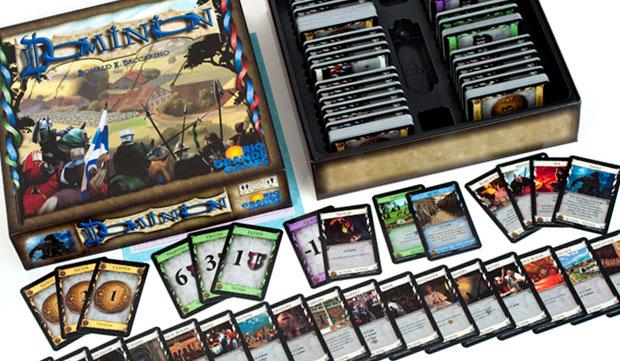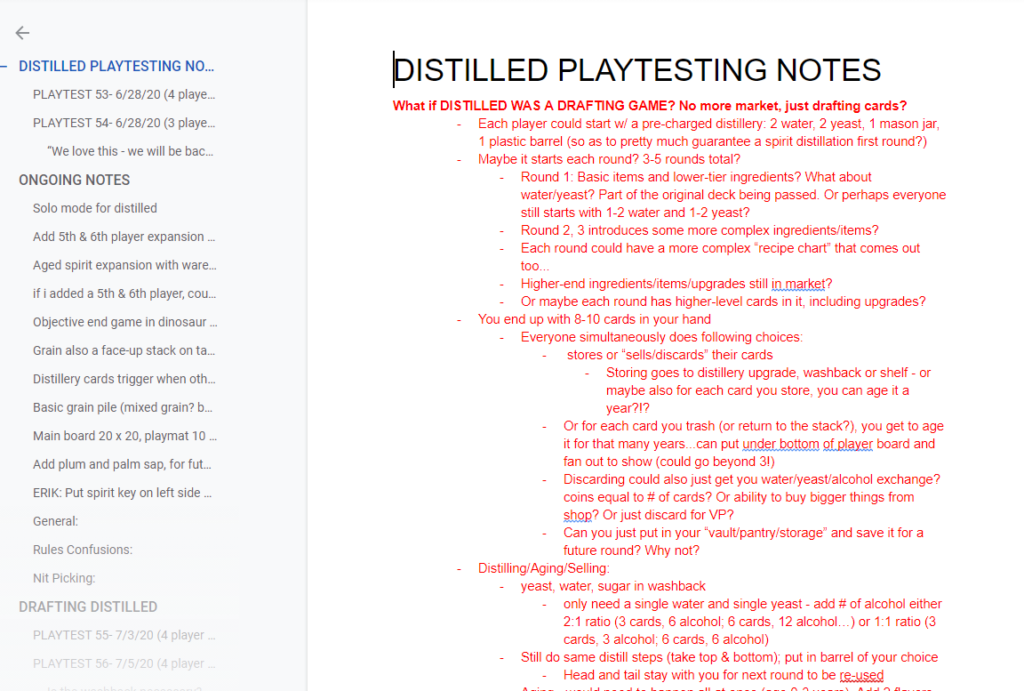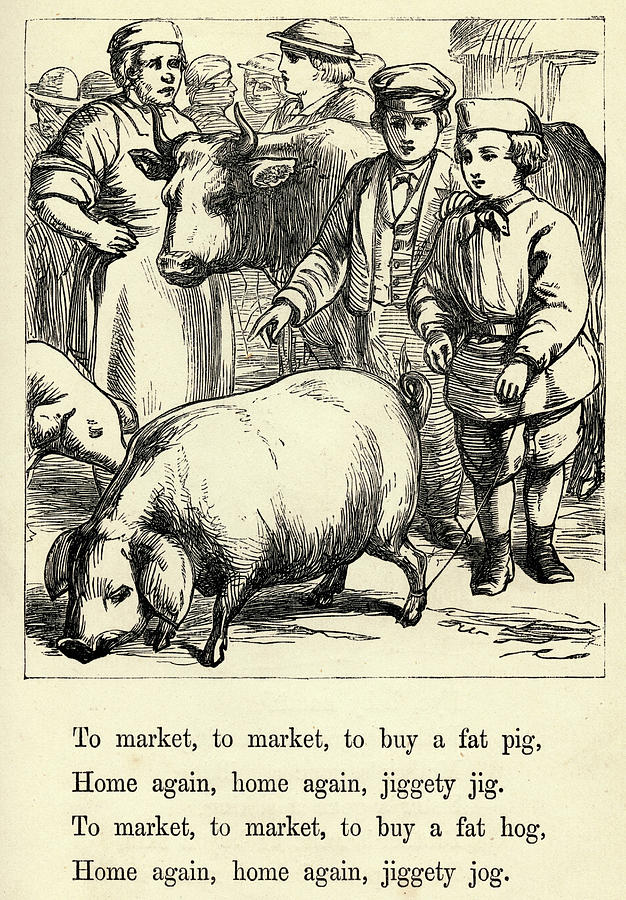This is the first in a four-part blog series where I’d like to walk through the changes I’ve decided to make to Distilled over the past two months. I believe (hope? PRAY?!) that these changes have taken the game from a collection of fiddly bits towards something that is fun to play while also being both unique and functioning.

As you’ll recall from my previous post, I had a big epiphany in early July, about how to redesign the game. One of the biggest critiques from a small group of people was Distilled’s deck-building elements. But boy, was that small group vocal. A deck builder means that a player begins with a small, simple deck of cards which may have power, actions, or money associated with them, and those cards tend to be fairly weak. Over the course of the game, the player is encouraged to “build up their deck” by acquiring new cards (and trashing starting cards) that would make their engine – the deck itself – a more powerful, efficient machine. Many say Dominion invented the deck builder genre, but that’s an argument that I’ll leave for another day (it was my first deck building experience, and actually my first modern, designer board game that I played, launching me into this obsession!). Since deck building tends to have a fast-paced, engine/chain-building focus, the type of player it attracts can be pretty hardcore and opinionated towards that specific type of mechanic or game. They know what a deck builder is, and they’re looking for the next greatest and unique version to satiate their appetites.

The problem was, Distilled never had the intention of being a fast-paced, engine building game – nor one that would chain effects. I had simply landed on the idea of the deck building mechanic being a good one to incorporate the acquisition of ingredients and items over time, which would eventually help a player to craft spirits. I originally did have “actions” or “effects” on all the cards (“play this Rye card to have all players discard a card”), but those things were getting in the way of the true goal of the game – to distill alcohol using the cards in your hand as ingredients. So it came as no surprise when – after I’d removed the card’s actions – that it felt like a really really bad deck builder.

I needed a change. I knew I wanted to still have cards (over cardboard chits) as the main component for the game. It allows for Erik to create amazing illustrations, is fairly cheap to produce, and lets me add variability to the game in future expansions and modules. Also, before playing my game, many will mention Viticulture and Brew Crafters as two games that remind them of the theme (about wine making and beer making, respectively). Both of those games are great worker-placement games (especially Viticulture, which I absolutely love), so I knew I wanted to stick with mechanics that made Distilled unique (those same people often comment afterwards about how the theme of alcohol really is the only similarity with those other games).

Due to my previously mentioned all-night, insomniac-fueled creative bender in early July, I wrote down a bunch of notes about the possibility of Distilled being a drafting game instead of a deck-building game. I started calling everything “DD” for “Drafting Distilled”, and essentially bifurcated the project into two separate tracks. I would continue to have the deck building version up on the Steam Workshop but also develop an experimental version on the side that I would play test privately with groups. A card draft is another interesting concept in games, but not used nearly as much as deck building (some popular games include 7 Wonders and Sushi Go). In the most basic form of the draft, players all start with the same number of cards (let’s say, 5). They pick a single card from that five, and then pass the other 4 cards to the player on their left. The player to their right is doing the same thing, so they will now receive 4 new cards into their hand, of which they will choose 1 to keep. This proceeds until their are no cards left (usually the final card is discarded). This allows for a randomized distribution of cards, yet the ability to have some agency for the player (both in what they choose, and what they may be trying to keep from their opponent).

In the former Distilled, players started with a simple deck of cards (of which they’d draw cards, use those cards to buy from the market or store in their distillery to make alcohol) and build it up (or down) over the course of the game. They’d tend to make 3-4 spirits over a 10 round game. There were many things awkward about that version, and I decided that by removing the “deck building” aspect and replacing it with a card draft, I could solve a number of issues:
- Where downtime was a problem between turns before (people would take a long time to buy from the market), now it was essentially nonexistent because of a draft.
- Players would continually get new cards from the draft each round, contributing to their spirit recipe and also potentially affecting other players by what they choose to take from the draft (or not).
- It allowed me to adjust the rules so that players would be crafting a new spirit every round. Feedback I received in all play tests told me that their favorite part of the game was making spirits, so why limit them to doing it only a few times per game?

While it wasn’t perfect or pretty on the first play through, this new version felt right. It was quicker and faster. It allowed people to make a variety of spirits throughout the game. It stopped some of the AP that was happening before with the market (AP is “analysis paralysis”, where a player has a bunch of decisions in front of them, and they simply can’t make a decision because they’re worried they’ll commit to the wrong strategy (or they’re trying to crunch numbers in their head). With Seth Berrier’s help, he was able to script a new feature that allowed for the draft to happen quickly and automatic (by the push of a button!). It also helped me whittle Distilled down to just FIVE ROUNDS and TWO PHASES:

I could now have people think of one phase being all about “the cards” (drafting and buying, called the MARKET PHASE) and the other phase being all about “the distillery” (planning out where your cards will go, distilling, aging, and bottling spirits, called the DISTILLERY PHASE). Except for a few key points of a round, things could also be concurrent, which meant that players could all perform the action at once (such as the drafting step). I enjoy this about Quacks of Quedlinburg and Taverns of Tiefenthal, two games designed by Wolfgang Warsch, and was excited to be able to incorporate this “non-competitive” aspect of gameplay into the Distilled experience.
:strip_icc()/pic4575864.jpg)
But with the deck building aspect gone, and the draft looking better with every play, I also knew that I couldn’t rely entirely on the draft for players to obtain the cards they needed. Since there are various recipes and goals requiring specific cards (ingredients and items) in the game, it is important to provide some choice and strategy for the players, rather than just the luck of what is passed to you in the draft. With this issue, combined with the fact that players would still be earning money through the bottling and selling of their spirits (and thus eligible to spend that money!), led me to realize that I still needed a Market, but it would take on a slightly different form than its previous iteration.
Next time, I’ll talk about the new Market, and how it is aiming to provide additional complexity and strategy to the game (and how it still continues to be a part I’m trying to improve!).
